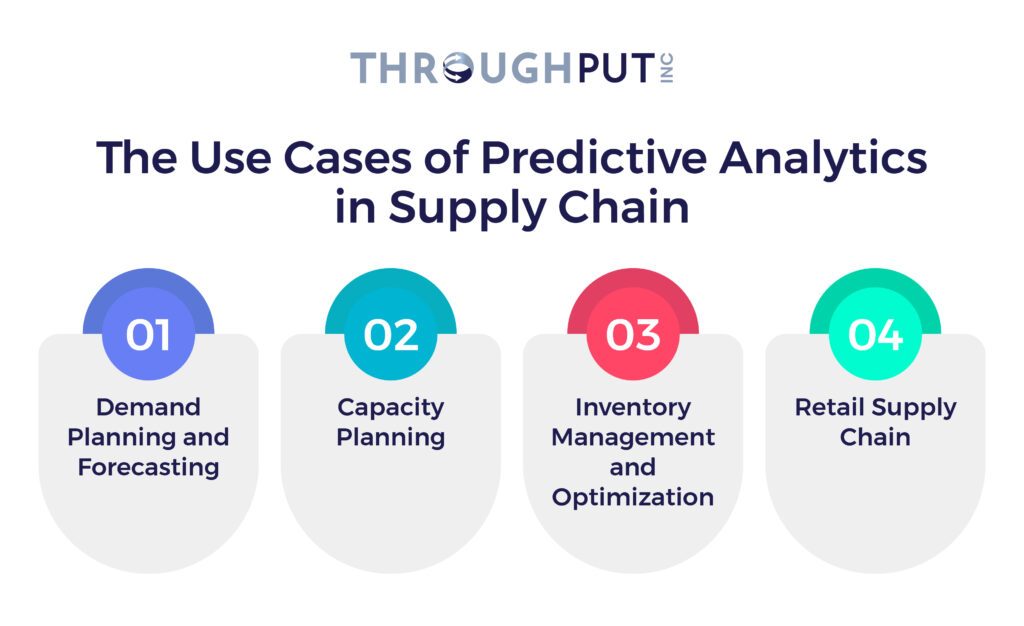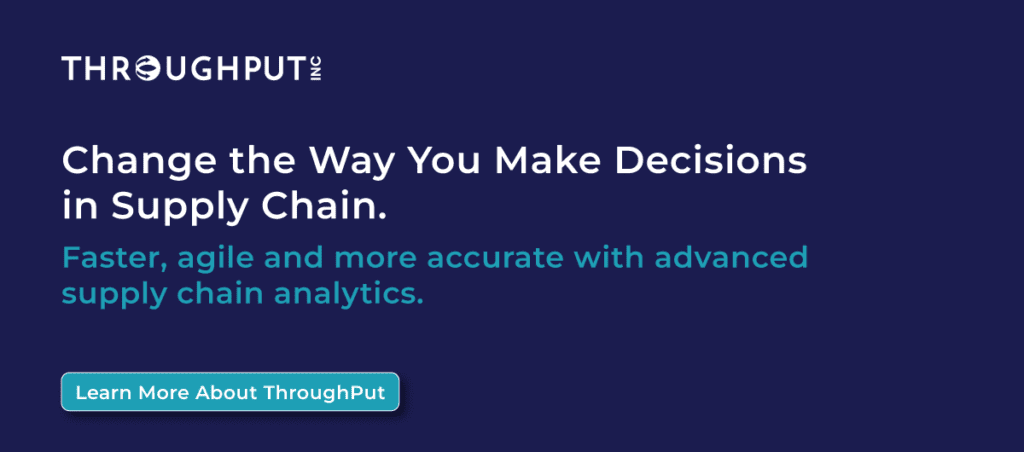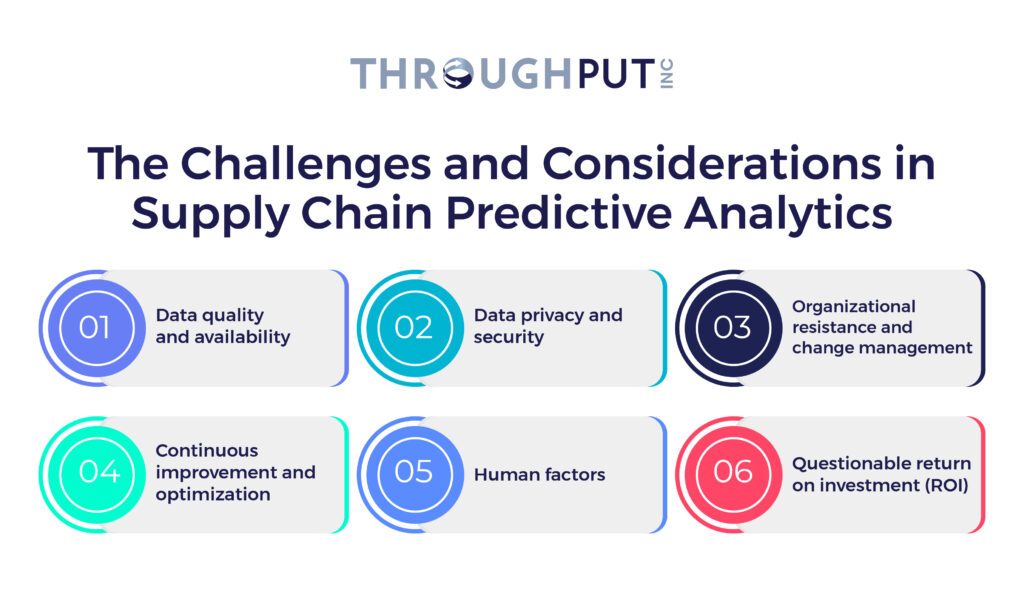Supply Chain Predictive Analytics: Benefits, Use Cases and Growth Potentials

Supply chains used to live in the past. Questions like “what happened?” and “why it happened?” dominated conversations across functions. Not anymore. Thanks to the more advanced forms of supply chain analytics like predictive analytics, supply chains are proactively looking into the future and prepping for “what is to come” rather than only ruminating over “what already happened.”
Unlike diagnostic and descriptive analytics, which were designed to analyze situations after they happened, predictive analytics utilizes advanced data analytics techniques to forecast future outcomes. It enables companies to make proactive decisions and stay ahead of the competition.
Supply chain predictive analytics enhances operational efficiencies and offers a unique competitive edge in today’s fast-paced business landscape.
Businesses can access historical data, market trends, and other external factors and, by plugging in predictive analytics, gain invaluable insights that streamline inventory management, demand forecasting, transportation planning, risk mitigation, and overall decision-making processes. Not so surprisingly, the 2021 MHI Annual Industry Report found that 31% of the respondents were already using predictive analytics in some capacity, and 48% were planning to invest in it in the next 5 years.
So, in this article, we will dive deep into the concept of predictive analytics in supply chain management and discuss its most powerful use cases.
What Is Predictive Analytics for Supply Chain?
Predictive analytics for the supply chain leverages data, statistical algorithms, and machine learning techniques to identify the likelihood of future outcomes. The goal is to go beyond knowing what has happened to provide the best assessment of what will happen.
For instance, an apparel store can prepare for the upcoming summer by using predictive analytics to identify products most likely to witness higher and lower sales and stock their shelves accordingly.
Predictive analytics is no new concept. However, access to vast amounts of data and the technological capability to analyze this data faster has brought more accuracy and credibility to predictive analytics in recent times.
When companies leverage data from various sources such as sales history, market trends, and external factors, predictive analytics paired with supply chain intelligence provide valuable insights that enable better decision-making and proactive planning – like never before.
Predictive analytics encompasses advanced techniques to forecast future events based on historical data, including data mining, regression analysis, time series forecasting, and optimization algorithms.
Data mining, for instance, delves deep into vast datasets, uncovering hidden patterns and correlations.
Regression analysis, on the other hand, examines the relationship between variables, helping determine the strength and nature of these associations.
Time series forecasting focuses on predicting future data points based on past sequences.
Meanwhile, optimization algorithms seek the best solution in decision-making scenarios, refining processes to achieve maximum efficiency or profitability.
What Are the Benefits of Connected Predictive Analytics and Supply Chains?
Companies implementing supply chain predictive analytics experience a multitude of benefits. Some of the top benefits include:
- Accurate determination of customer demand
- Efficient inventory management
- Reduction of stock-outs
- Elimination of overstock situations
- Improved logistics management
Furthermore, predictive analytics aids in identifying potential disruptions and bottlenecks in the supply chain. For companies, that means informed adjustments and keeping operations running smoothly without running into downtimes and delays.
From a strategic perspective, predictive analytics empowers companies and supply chain teams to optimize resource allocation, reduce costs, and improve customer satisfaction.
What Are the Use Cases of Predictive Analytics in Supply Chain?
There isn’t a shortage of applications for predictive analytics and the impact it can have on the supply chain. Let’s check out the most common use cases.

Demand Planning and Forecasting
Accurate demand planning and forecasting ensure businesses meet customer needs while minimizing costs.
One of predictive analytics’ most powerful use cases is to improve demand forecasting and planning by identifying hidden trends, patterns, and seasonality in customer demand. Unlike traditional forecasting, predictive analytics can analyze multiple variables, including historical sales data, market trends, and external factors, and identify patterns and trends that may also miss the most trained human eyes.
And accurate forecasts mean better production planning, inventory management, resource allocation, and overall planning.
Capacity Planning
Capacity planning is a critical aspect of supply chain management. It involves determining the optimal level of resources required to meet future demand.
With the ability to analyze historical data and identify patterns, predictive analytics can help with accurate demand forecasts, allowing supply chain professionals to make informed decisions about production levels, staffing, and resource allocation.
Inventory Management and Optimization
Effective inventory management is vital for maintaining the right balance between stock availability and carrying costs.
So, how does predictive analytics help with that?
By giving companies insights on how to manage their inventory more effectively. Analytics does that by predicting demand, optimizing stock levels as per demand, and reducing the risk of stockouts or overstocking.
Retail Supply Chain
In the retail industry, predictive analytics is especially helpful in improving supply chain operations.
Typical use cases include forecasting demand, optimizing inventory levels, and identifying potential bottlenecks. For retailers, that means ensuring that products are available when and where customers need them.
Additionally, predictive analytics assist retailers with optimizing store operations:
- staffing levels
- store layouts
- promotional activities
All this leads to improved customer satisfaction and increased sales, which counts at the end of the day.
Manufacturing Process
Predictive analytics also significantly optimize manufacturing processes by identifying bottlenecks, predicting equipment failures, and improving overall efficiency.
Just imagine all the data from sensors, production logs, and maintenance records.
When predictive analytics is used to analyze all that data, supply chain professionals get insights into potential issues that may arise and the corrective actions they need to take.
This proactive approach means manufacturers can reduce downtime, improve product quality, and increase operational efficiency.
Managing Supplier Performance and Reducing Risks
Predictive analytics can also help businesses manage supplier performance and reduce risks. Analytics uses performance metrics to identify potential bottlenecks, delays, or quality issues.
As a result, supply chain experts can take decisive measures such as renegotiating contracts, diversifying supplier portfolios, or implementing contingency plans. The advanced risk management and prediction models ensure a stable and reliable supply chain, with as few disruptions as possible and customer satisfaction at the highest level.
Predictive Analytics for Logistics and Transportation Management
Logistics and transportation management are among the most prominent use cases of predictive analytics. Let’s examine why pairing predictive analytics and supply chain is vital for the logistics industry.

How Predictive Analytics Can Enhance Logistics and Transportation Management
Predictive analytics in logistics and transportation management enables logistics teams and leaders to make more informed and proactive decisions. Looking at data from various touchpoints in the supply chain, the analytical systems show businesses how to identify potential issues in logistics before they occur and how to take appropriate actions to mitigate those risks.
For instance, predictive analytics can help optimize transportation routes and schedules better. That’s because analytics can look at multiple factors – internal and external – that contribute to the efficiency of vehicular movement and create efficient routes and schedules that minimize costs and maximize customer satisfaction.
Real-time tracking and monitoring of shipments using predictive analytics
A critical application of predictive analytics in logistics and transportation management is real-time tracking and monitoring of shipments. Many companies have found a way to integrate predictive analytics with IoT devices and sensors to collect real-time data on the location, condition, and status of their shipments.
The real-time visibility helps proactively address potential delays, damages, or disruptions in the supply chain. With access to accurate and up-to-date information, supply chain professionals can immediately resolve issues, notify customers, and make necessary adjustments to ensure on-time delivery.
Optimization of transportation routes and schedules based on predictive insights
Predictive analytics can also play a role in optimizing transportation routes and schedules. The data-powered system can identify patterns and trends that can guide decision-making.
For example, it is possible to identify the most efficient routes based on factors such as traffic congestion, road conditions, and delivery deadlines. Or determining the ideal number and placement of distribution centers to ensure timely delivery and minimize transportation costs.
Data and Forecasting in Supply Chain Predictive Analytics
Two aspects that are at the heart of predictive analytics’ effectiveness are data and the forecasting technique.
Leveraging Predictive Analytics Through Data
The first step in leveraging predictive analytics is collecting, storing, and managing vast supply chain data. This includes sales, inventory, production, transportation, and customer behavior data. Effective data management means that data integrity and accessibility for analysis have to be in place.
Various data types used in supply chain predictive analytics include historical, real-time, external, and qualitative data. These data sources provide trends, patterns, and potential disruptions within the supply chain.
However, data cleansing and preprocessing techniques need to be employed to ensure accurate predictions. We refer to identifying and fixing any inaccuracies, inconsistencies, or missing data. Preprocessing techniques like normalization and smoothing help remove noise and outliers, allowing for more precise forecasting.
Forecasting Methods and Techniques
Numerous forecasting methods are available – time series analysis, regression analysis, and machine learning algorithms, to name a few.
Each method has its strengths and weaknesses, and the choice of method depends on the specific supply chain scenario you are trying to solve.
Forecasting techniques are applied to predict various aspects of supply chain management, including demand forecasting, inventory planning, production scheduling, and transportation optimization. Choosing and implementing the proper techniques means that organizations can anticipate future demands accurately and make proactive decisions.
And we should remember accurate forecasting. This part is critical for effective supply chain optimization. Forecasting impacts all aspects of supply chains, such as inventory carrying costs, stockout levels, lead times, transportation routes, etc.
So, when you leverage predictive analytics, you can expect a well-balanced supply chain that meets customer demand efficiently.
Enterprise-wide Implementation of Supply Chain Predictive Analytics
Implementing supply chain predictive analytics across an entire enterprise can be a significant challenge. However, with careful planning and execution, the benefits are worth the effort.
Here are three aspects you need to take care of while implementing predictive analytics on an enterprise-wide scale.
1. Integration of predictive analytics into existing systems
Integrating predictive analytics into any existing supply chain involves several challenges and considerations:
- The implementation process can face compatibility issues, data quality challenges, and organizational resistance. Overcoming these challenges is crucial for successful integration.
- You must identify and utilize the existing data sources and IT infrastructure to achieve a seamless integration process. This is tough, but it removes unnecessary investments and improves efficiency.
2. Building a predictive analytics team
Implementing predictive analytics requires a dedicated team with specific roles and responsibilities:
- The team typically includes data scientists, analysts, domain experts, and project managers. Each member plays a vital role in the implementation process.
- The team members need to possess skills such as data analysis, statistical modeling, programming, and domain knowledge in supply chain management.
3. Adoption of predictive analytics tools and technologies
Finally, we shouldn’t forget the array of tools and technologies needed for the implementation:
- There are numerous software and tools available in the market. Understanding their features and capabilities is crucial in selecting the right solution.
- Organizations must evaluate factors such as ease of use, scalability, integration capabilities, and cost-effectiveness before deciding.
All this shows that planning and implementing predictive analytics into the current company structure can be a long process. A guided step-by-step approach that considers the above three pointers will be critical in determining the success of enterprise-wide implementation.

What Are Some Case Studies and Success Stories of Supply Chain Predictive Analytics Implementation?
If you think that implementing predictive analytics is tough, you are right. But there are numerous examples that show this is possible.
- During the COVID-19 pandemic, Western Digital used the Predictive Risk engine developed to protect its supply chain and saved millions of dollars before disruption hit.
- Walmart uses data analytics to optimize its supply chain, manage inventory, and improve its online and in-store shopping experience. The company collects data from millions of transactions and online searches to identify what products are selling and adjust its supply chain accordingly.
- UPS leverages predictive analytics to gain insight into its logistics network. The company delivers approximately 21 million packages daily, with an increased demand during the peak periods. Using predictive analytics, UPS optimizes its delivery routes, reduces fuel consumption, and improves overall efficiency.
- DHL and Maersk are logistics giants that have developed predictive solutions to optimize their logistics and supply chain operations while pairing them with predictive analytics to improve efficiency and reduce costs. DHL uses predictive analytics for anticipatory shipping and stocking, which reduces food waste in the US.
As you can see, these examples demonstrate the transformative potential of predictive analytics in supply chain management.
What Are the Challenges and Considerations in Supply Chain Predictive Analytics?
Predictive analytics can’t work magic on your supply chain unless you create the right environment. And what does that mean? We’ll tell you in this chapter.

Data quality and availability
Predictive analytics works best on accurate, complete data and is free from errors, inconsistencies, and duplicates. As an extra point, you must integrate data from various sources to create a comprehensive dataset for effective predictive analytics.
Data privacy and security
Protecting sensitive data and ensuring compliance with data governance policies and regulations can become a significant challenge when implementing predictive analytics in supply chain management. However, that’s an effort you can’t bypass. For instance, you often need to encrypt data to safeguard it from unauthorized access.
Organizational resistance and change management
Overcoming resistance to change within the organization and gaining buy-in from stakeholders is challenging for any significant system upgrade. And the implementation of predictive analytics is no exception.
As a company, you must push for effective communication, training, and education to ensure employees understand the value and use of predictive analytics.
A good practice would be to appoint individuals who will act as change champions and implement pilot analytics projects to start small.
Continuous improvement and optimization
Predictive analytics models must be regularly assessed, refined, and updated based on new data and insights. For organizations, that means establishing a feedback loop and continuous improvement practices to enhance the accuracy and effectiveness of predictive analytics solutions.
To optimize predictive models, you must use machine learning algorithms to improve the accuracy and feature engineering to select the most relevant features that reduce model complexity.
Human factors
Implementing predictive analytics in supply chain management requires domain knowledge, analytical skills, and technical expertise. Finding and nurturing the right talents is, without any doubt, a big challenge.
Questionable return on investment (ROI)
As the last point, implementing predictive analytics in supply chain management can require significant investment in infrastructure, technology, and personnel, as mentioned above.
So, if your organization is serious about upgrading its analytics, you must carefully outweigh the costs with a potential return on investment (ROI) of a predictive analytics solution. And you are considering all phases – from planning to implementation and maintenance.
Future Trends in Supply Chain and Predictive Analytics
So, what lies ahead for predictive analytics and supply chain management? Is predictive analytics here to stay? Let’s find out.
Overview of Emerging Technologies and Trends
Supply chain predictive analytics is expected to integrate with emerging technologies such as the Internet of Things (IoT), blockchain, and augmented reality.
These advancements will allow companies to improve real-time visibility and data accuracy and streamline collaboration across different supply chain stages. Using IoT devices and sensors means the supply chain will become more interconnected and responsive, and the vast amounts of data will help accurate forecasting.
Future Role of Predictive Analytics in Supply Chain Management
Predictive analytics will play an even more crucial role in supply chain management in the future.
Companies will heavily rely on predictive models and algorithms to anticipate demand fluctuations, optimize inventory levels, and identify potential disruptions. There will be enhanced accuracy and speed in data analysis to help supply chain managers make proactive decisions and promptly respond to changing market conditions.
We also expect predictive analytics to become integral to driving cost savings, improving customer service, and ensuring supply chain resilience.
Implications of AI and Machine Learning Advancements on Supply Chain Predictive Analytics
The advancements in artificial intelligence (AI) and machine learning techniques will revolutionize supply chain predictive analytics. You can expect AI-powered algorithms to enable the identification of complex patterns and correlations within datasets.
Machine learning will fuel automated decision-making processes, dynamically adjusting predictive models based on new data inputs. With this will come the opportunity for increased automation, reduced manual intervention, and improved overall supply chain performance.
Closing Thoughts
As we venture into the next era of supply chain management, predictive analytics will help supply chains be efficient and prescient—almost having a sixth sense. Those who harness the power of predictive analytics will lead, setting new benchmarks in agility, resilience, and innovation.
And with Artificial Intelligence and Machine Learning, predictive analytics is only expected to get more powerful. Currently, the supply chain world is also witnessing the emergence and use of prescriptive and cognitive analytics, both built on the solid foundation of predictive analytics.

FAQs for Predictive Analytics in Supply Chain
Question: How can predictive analytics help me reduce unplanned downtime across plants and critical assets?
Answer: Predictive analytics analyzes sensor data, equipment history, maintenance logs, and environmental variables to detect early failure signatures before breakdowns occur.
For Maintenance Heads, this means:
- Predicting failure weeks in advance
- Optimizing maintenance intervals
- Reducing spare parts emergencies
- Improving asset uptime and OEE
This shifts maintenance from reactive or calendar-based to fully predictive, eliminating costly line stoppages and firefighting.
Question: How does predictive analytics improve forecast accuracy for complex, multi-SKU manufacturing?
Answer: Predictive models process thousands of variables — past sales, seasonality, promotions, supply risks, macroeconomic indicators, customer behavior, and even supplier lead-time variability.
For Supply Chain VPs, this means:
- Cutting forecast error by 20–40%
- Reducing bullwhip effects
- Aligning production plans with true demand
- Avoiding excess inventory and stockouts
It helps teams plan with confidence, even in volatile markets.
Question: Can predictive analytics help identify hidden bottlenecks that traditional Lean/Six Sigma misses?
Answer: Yes. Predictive analytics reveals pattern-based bottlenecks by analyzing multi-stream data that humans cannot detect manually.
It pinpoints:
- Repeated micro-delays
- Queue buildups
- Resource underutilization
- Upstream and downstream constraints
- Correlation between machine behavior and throughput
This helps operations leaders make decisions that directly increase throughput and reduce cycle times.
Question: How does predictive analytics help sourcing teams manage supplier risk and improve reliability?
Answer: Predictive analytics evaluates supplier performance using historical data, quality metrics, delivery reliability, geopolitical signals, logistics data, and financial stability markers to predict future disruptions.
For Sourcing Directors, this enables:
- Early identification of at-risk suppliers
- Predictive lead-time variability analysis
- Contingency planning before disruptions hit
- Improved supplier scoring and selection
This protects production continuity and reduces last-minute scrambling.
Question: How quickly can industrial companies see ROI from implementing predictive analytics?
Answer: Industrial companies typically see ROI within 3–6 months because improvements hit core cost drivers:
- Reduced unplanned downtime
- Lower inventory carrying cost
- Higher OTIF levels
- Fewer expedited shipments
- Optimized workforce and capacity
- Better asset utilization
Predictive analytics improves both top-line agility and bottom-line efficiency, accelerating payback.
Question: Does predictive analytics integrate with ERP, MES, WMS, and SCADA systems without needing a tech overhaul?
Answer: Yes. Modern predictive analytics platforms are designed to layer on top of existing systems.
For system-heavy industries, they plug into:
- SAP, Oracle, Infor
- MES platforms
- WMS/TMS solutions
- Plant SCADA and IoT systems
This avoids re-platforming and delivers value fast while using your current data infrastructure.
Question: How does predictive analytics support end-to-end visibility for multi-plant or global operations?
Answer: It consolidates data across plants, suppliers, logistics, and customers into a unified model.
Operations leaders gain:
- Real-time performance predictions
- Cross-plant benchmark visibility
- Predictive alerts for incoming disruptions
- Unified inventory and capacity view
This creates a proactive control tower for enterprise-wide decision making.
Question: Can predictive analytics reduce excess working capital tied up in inventory?
Answer: Yes—by predicting demand and optimizing safety stock levels.
It helps companies:
- Reduce slow-moving and dead stock
- Free up capital trapped in warehouses
- Balance inventory levels per customer segment
- Increase inventory turns
This is especially valuable for manufacturers with long lead times and high SKU complexity.
Question: How does predictive analytics help improve OTIF and customer service levels?
Answer: Predictive analytics identifies the root causes of poor OTIF such as:
- Lead-time variability
- Production bottlenecks
- Logistics delays
- Inventory inaccuracies
By addressing these early, companies can drastically improve perfect order performance without adding cost.
Question: What skills or team structure do we need to successfully implement predictive analytics?
Answer: While advanced data teams help, modern platforms require minimal in-house data science.
Industrial companies typically leverage:
- A supply chain analyst or planner
- A maintenance or operations engineer
- A business leader (Director/VP)
- Vendor implementation support
Most modern predictive analytics tools come with pre-built models, making onboarding fast and low-risk.
Question: How does predictive analytics help manage spare parts availability without inflating the MRO inventory budget?
Answer: It predicts which components are likely to fail soon, based on usage, cycles, historical failures, and environmental data.
Maintenance teams can:
- Stock critical parts proactively
- Avoid emergency procurement
- Reduce overall MRO inventory value
- Eliminate obsolete spare parts buildup
This ensures high uptime with lower capital tied in spare parts.
Question: Will predictive analytics still work if our data is messy or incomplete?
Answer: Yes—modern platforms use cleansing, normalization, anomaly detection, and interpolation techniques.
They are designed specifically for real-world industrial data that is often:
- Incomplete
- Inconsistent
- Cross-system
- Non-standard
The system generates reliable predictions even before full data maturity is achieved.

